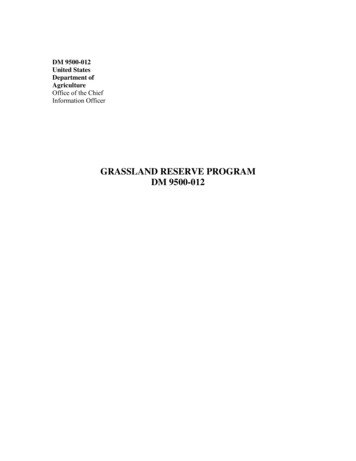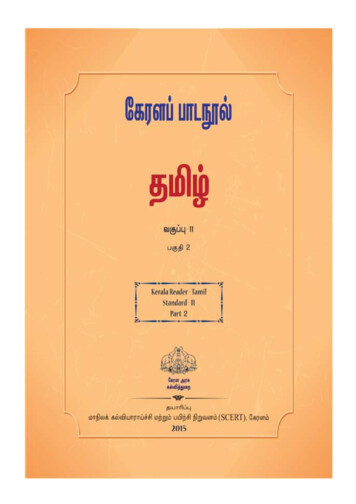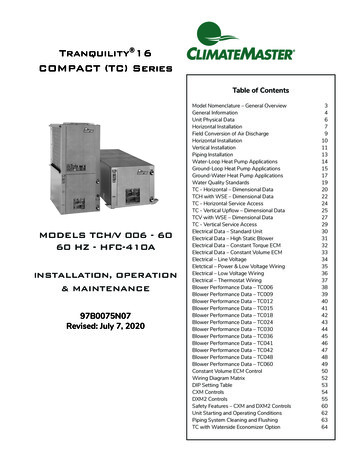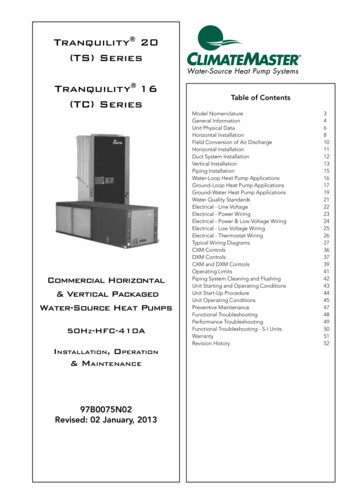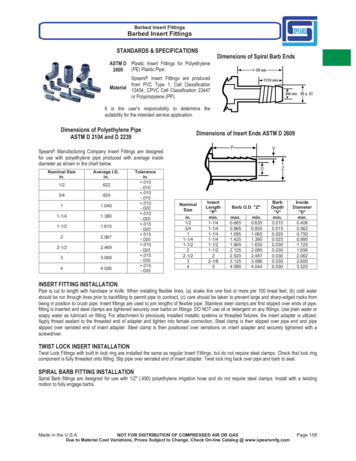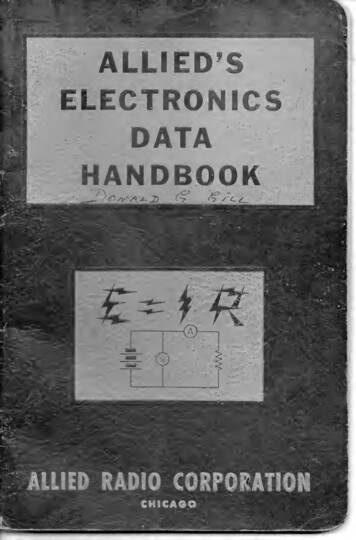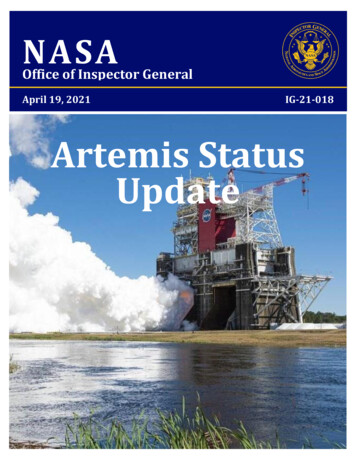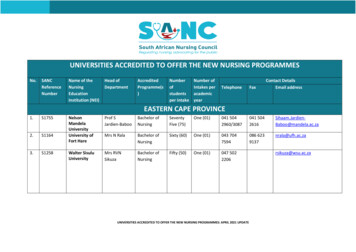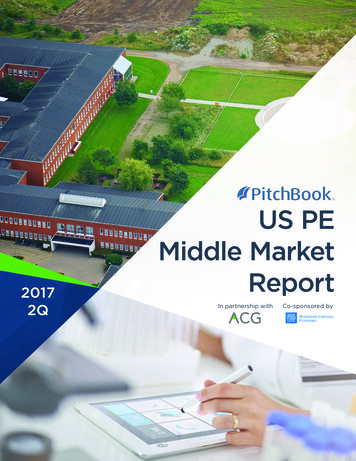
Transcription
20172QUS PEMiddle MarketReportIn partnership withCo-sponsored by
I N PA R T N E R S H I P W IT HCredits & ContactPitchBook Data, Inc.JOHN GABBERT Founder, CEOADLEY BOWDEN Vice President,Market Development & AnalysisContentNICO CORDEIRO AnalystBRYAN HANSON Data AnalystJ ENNIFER SAM Senior Graphic DesignerContact PitchBookpitchbook.comRESE 4Introduction5Overview6-7Deals by Middle-Market Segment8Spotlight: Company Inventory9Exits10Fundraising11League Tables12COPYRIGHT 2017 by PitchBook Data, Inc.All rights reserved. No part of this publicationmay be reproduced in any form or by anymeans—graphic, electronic, or mechanical,including photocopying, recording, taping, andinformation storage and retrieval systems—without the express written permission ofPitchBook Data, Inc. Contents are based oninformation from sources believed to be reliable,but accuracy and completeness cannot beguaranteed. Nothing herein should be construedas any past, current or future recommendationto buy or sell any security or an offer to sell, ora solicitation of an offer to buy any security.This material does not purport to contain all ofthe information that a prospective investor maywish to consider and is not to be relied upon assuch or used in substitution for the exercise ofindependent judgment.The PitchBook PlatformThe data in this report comes from the PitchBook Platform–ourdata software for VC, PE and M&A. Contact sales@pitchbook.comto request a free trial.3P I TC H B O O K 2Q 2017US PE MIDDLE MARKET REPORTCO -S P O N S O R
I N PA R T N E R S H I P W IT HMETHODOLOGYMIDDLE MARKET DEFINITIONFor this report, the middle market (MM) is defined as US-based companies acquired through buyout transactionsbetween 25 million and 1 billion. Note that minority deals are not included. The middle market is further brokendown into the lower middle market (LMM; 25 million to 100 million), the core middle market (CMM; 100 millionto 500 million) and the upper middle market (UMM; 500 million to 1 billion). The lower bound of each range isinclusive of deals that are that exact amount, e.g. a transaction that is 100 million in size will be bucketed into theCMM rather than the LMM. This report covers only US-based middle-market companies that have received some typeof private equity investment.DEAL FLOW ESTIMATIONDue to the nature of private market data, information often does not become available until well after a transactiontakes place. To provide the most accurate data possible, we estimate how much of this new information willbecome available in the next quarter by calculating the average percentage change in deal flow from the first tothe second reporting cycle over the trailing 24 months. We then add this estimate to the reported figure for themost recent quarter. Both the original reported figure and the estimated figure are provided for your reference.TOTAL CAPITAL INVESTED/DEAL VALUETotal amount of equity and debt used in the private equity investmentEx. 10 million of equity and 20 million of debt 30 million of total capital investmentPitchBook’s total capital invested figures include deal amounts that were not collected by PitchBook but havebeen estimated using a multidimensional estimation matrix, which takes into account year of investment, deal type,platform v. add-on, industry and sector. Some datasets will include these extrapolated numbers while others willbe compiled using only data collected directly by PitchBook; this explains any potential discrepancies that may benoticed.EXITSThe report includes both full and partial exits of middle-market companies via corporate acquisition, secondaryPE buyout and initial public offering (IPO). PitchBook has utilized its multidimensional substitution and estimationmatrix to estimate transaction sizes where the deal amount is unknown. For the MM company inventory, we includedcompanies that are expected to exit between 25 million and 1 billion.FUNDRAISINGPitchBook defines middle-market funds as PE investment vehicles with between 100 million and 5 billion in capitalcommitments. The report only includes PE funds that have held their final close. Funds-of-funds and LP secondaryfunds are not included.LEAGUE TABLESAll league tables are compiled using deal counts for middle-market leveraged buyouts only to better reflect theother datasets within the report, with only the Lenders table also including all PitchBook debt round types in order tocapture all debt provided to facilitate buyouts. For example, the Most Active Advisors league table shows the numberof US-based middle-market buyouts that a firm advised on during the second quarter of 2017. Deals on which a firmadvised multiple parties will only be counted once for that firm.Madison Capital, founded in 2001, and headquartered in Chicago, Illinois, is apremier finance company focused exclusively on the corporate financing needsof middle-market PE firms. Madison Capital has closed transactions with over255 different private equity firms and provides enterprise-value leveragedfinancing for leveraged buyouts, management buyouts, add-on acquisitions and recapitalizations. Madison Capital FundingLLC is a subsidiary of New York Life Insurance Company. Additional information may be found at: www.mcfllc.com4P I TC H B O O K 2Q 2017US PE MIDDLE MARKET REPORTCO -S P O N S O R
I N PA R T N E R S H I P W IT HINTRODUCTIONKey takeaways Middle-market PE firms invested 236.9 billion across 1,086 deals in 1H 2017.The volume of deals is nearly on pace with last year, but PE firms are spendinggreater amounts of capital as activity has moved into the core and upper middlemarkets. Middle-market PE investment in tech companies so far this year exceeds thetotal amount invested in all of 2016, with 65 billion over 175 deals. There have been 23 PE exits through IPO this year, nearly as much as allof 2016. With another 22 PE-backed companies in registration, it looks likedecreased M&A activity is resulting in an increase of IPOs for PE firms looking toexit. Middle-market fundraising continues to be strong, making up 75% of all PEfunds closed this year. Despite a slight slowdown in fundraising numbers, thetime it’s taken for a fund to close is down from 15 months two years ago to just10 months for funds closed this year.We hope this report is useful in your practice. As always, feel free to send anyLook up a company.And its cap table.And its investors.And its EBITDAmultiples.And its boardmembers.In seconds.questions or comments to reports@pitchbook.com.The PitchBook Platformhas the data you needto close your next deal.NICO CORDEIROAnalystLearn more atpitchbook.com5P I TC H B O O K 2Q 2017US PE MIDDLE MARKET REPORTCO -S P O N S O R
I N PA R T N E R S H I P W IT HSHIFT TO CORE &UPPER MIDDLE MARKETOverviewPE firms invested 236.9 billion over1,086 deals in the middle marketduring the first half of the year. Whiledeal volume is on pace with last year,the amount of capital invested is up23% over the first six months of 2016.This is driven by increased activity inthe core and upper middle market aslower-middle-market activity droppedsharply. Upper-middle-market (UMM)activity has trended upward since 1Qof last year and continues to climb,accounting for more deals than thelower middle market for the first timein our dataset. The trend toward thecore and upper middle markets islargely driven by massive amounts ofdry powder and increases in averagefund size over the last few yearshave necessitated larger minimuminvestments. Unsurprisingly, mediandeal size in the middle market is up toDriven by sample size and dry powder, median deal size surgesMedian US PE middle-market transaction size ( M) 250 208.5 200 150 129.3 100Source: PitchBook*As of 6/30/2017 50 02006 2007 2008 2009 2010 2011 2012 2013 2014 2015 2016 2017*Staying elevatedUS PE middle-market activity 140Es mated Deal Value ( B) 120Deal Value ( B)# of Deals Closed# of Es mated Deals Closed700579600 19Source: PitchBook 100 118 97 91 101 92 108 102 105 97 115 116 104 117 88 79 60 71 107 69 71100 71 20 75200 67 40 66300 67 60 84400 53 80 53500 48 1000 01Q 2Q 3Q 4Q 1Q 2Q 3Q 4Q 1Q 2Q 3Q 4Q 1Q 2Q 3Q 4Q 1Q 2Q 3Q 4Q 1Q 2Q 3Q 4Q 1Q 2Q 3Q 4Q 1Q 2Q201020116P I TC H B O O K 2Q 2017US PE MIDDLE MARKET REPORT201220132014201520162017CO -S P O N S O R
I N PA R T N E R S H I P W IT Hcompanies are not capital intensiveand growth strategies are not subjectto capacity constraints. Expandingtop-line figures for a SaaS companyis generally confined to expandinga strong business development andsales team.OutlookWe expect deal flow in the middlemarket to finish strong throughthe second half of the year despitea high-priced environment. Theneed to deploy billions of dollars inUS middle-market M&A transaction .3x3.5x3.7x3.5x3.3x3.2x7.6x2006 2007 2008 2009 2010 2011 2012 2013 2014 2015 2016 2017*US PE MM deals ( ) by sectorMaterials & ResourcesHealthcareEnergy 400EnergyB2B 8x 450Financial ServicesB2CHealthcare2,0007.2x3.8x7.9x 500Materials & ResourcesValua on/EBITDASource: PitchBook*As of 6/30/20179.5xUS PE MM deals (#) by sector2,500Equity/EBITDA5.1xDebt/EBITDA3.7xIT deals accounted for an impressive 65 billion in deal value over 175 deals,surpassing the amount invested intech companies during all of 2016.This equates to roughly 30% of alldeal value in the middle market spaceand is more than double the 14%10-year average. The middle marketexemplifies the trend toward greaterPE involvement in tech as dealmakers,faced with stiff competition andhigh-priced assets, flock to softwarecompanies for two primary reasons.One, many of the software companiestargeted by PE employ a softwareas-a-service (SaaS) model. Thistype of business model is attractiveto PE because revenue is generallyrecurring and established in a serviceagreement. Such attributes allow PEfirms to more accurately forecastexpected revenue growth and providea form of risk management by ensuringthe company will not immediately loserevenue and/or clients following theacquisition process. Second, software5.8xPE buyers favor SaaScommitments and tight credit spreadsdue to a loose monetary policycontinue to make financing readilyavailable. On top of strong incentivesfor general partners to make deals,the economic outlook continues to bestrong in the short term with middlemarket businesses rebounding in2Q after a weak 1Q. Middle-marketrevenues are up nearly 9% andearnings by 2.3% year-over-year,according to the Golub Capital AltmanIndex.4.1x 208.5 million, another high point inour dataset. Due to a smaller numberof mega-deals through the first half ofthe year, middle-market deals madeup 68% of all PE deals during 1H,wellabove the 10-year average of 50%.Financial ServicesITSource: PitchBook*As of 6/30/2017B2C 3001,500 250 2001,000 150 100500 50 0020102011201220137P I TC H B O O K 2Q 2017US PE MIDDLE MARKET REPORT2014201520162017*Source: PitchBook*As of 6/30/20172010201120122013201420152016CO -S P O N S O R2017*
I N PA R T N E R S H I P W IT HLMM OFF PACEDeals by middle-market segmentPlenty of accessible capital and competition push up pricesUS PE UMM deal flowDeal Value ( B)UMM investmentremains more thanrobust.415# of Deals Closed3253382010201120122013201420152016 124.9 170.3 208.6 125.1 108.8 114.9194 194.2215218 116.6244Select US UMM PE deals in 2Q 20172662017*CompanyInvestor(s)DealSize( M)LongPointMineralsCanada PensionPlan InvestmentBoard 832LegendsHospitalityNew MountainCapital 700MitratechHgCapital 650CityMDWarburg Pincus 600Bob EvansRestaurantsGolden GateCapital 565Source: PitchBook. *As of 6/30/2017.Transactions sized between 500 million and 1 billion comprise the upper middle market.A decline partially attributable to pricing pressuresUS PE LMM activityDeal Value ( B)# of Deals ClosedSource: PitchBookEver variable, CMM still holding strongUS PE CMM activityDeal Value ( B)8818521,146# of Deals Closed7767771,026 1,024684719579822834522576 26.9 35.8 29.0 33.0 30.8 37.9 12.7 100.2 139.3 156.7 152.4 224.3 173.0 173.5 80.4438 1220132014201520162017Source: PitchBook. *As of 6/30/2017.Transactions sized between 25 million and 100 million comprise theupper middle market.8P I TC H B O O K 2Q 2017US PE MIDDLE MARKET REPORTSource: PitchBook. *As of 6/30/2017.Transactions sized between 100 million and 500 million comprise theupper middle market.CO -S P O N S O R
I N PA R T N E R S H I P W IT HINVENTORY UNREADYTO TURN OVERUS PE middle-market company inventoryUS PE middle-market company inventoryCompany Inventory4,1124,362% older 01520162017*Source: PitchBook*As of 6/30/2017Will M&A help PE firms offload aginginvestments again?There are currently 5,758 PEsponsored middle-market companiesin the US, a 40% increase since 2010.While this is not surprising givenrecord capital inflows to PE, what issurprising is the percent of companiesthat were acquired over five years ago,which now stands at 39.7%. This is thehighest percentage of aging inventoryin our dataset and could begin to poseliquidity problems if the exit marketdoesn’t heat up. We last saw a buildupof this kind in 2013, which was thenfollowed by an M&A frenzy, reachingrecord levels. This depleted agingPE inventory and drove median holdperiods down to five years. However,at this point in time, exits via M&A havebeen trending downward and it is notcertain that corporates will step up tohelp PE unload their investments.US PE middle-market median hold time by exit type6.56.05.4 5.75.55.15.44.53.5Source: PitchBook*As of 6/30/20172.5IPOCorporateSBO1.50.52006 2007 2008 2009 2010 2011 2012 2013 2014 2015 2016 2017*9P I TC H B O O K 2Q 2017US PE MIDDLE MARKET REPORTCO -S P O N S O R pa
data software for VC, PE and M&A. Contact sales@pitchbook.com to request a free trial.!"# %&'"(&)*! # !'* 3 !"# %"& "' PITCHBOOK 2Q 2017 US PE MIDDLE MARKET REPORT. METHODOLOGY Madison Capital, founded in 2001, and headquartered in Chicago, Illinois, is a premier nance company focused exclusively on the corporate nancing needs of middle-market PE rms.
